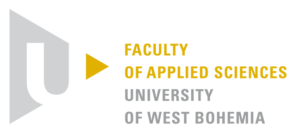Description
The Faculty of Applied Sciences of the University of West Bohemia in Pilsen performs fundamental and applied research in the fields of mathematics, geomatics, physics, cybernetics, information technologies, computer science and mechanical engineering. Since 2015, the faculty has been operating an R&D centre with 200 employees. The centre is equipped with state-of-the-art instrumentation and labs. There are 120 doctoral students at the faculty which participate at its research activities. The faculty cooperates with many partners within the Czech Republic and abroad.
Competences and capabilities
The research team of the faculty is competent in the areas of development of cybernetic control systems, identification, intelligent decision-making and communication systems; advanced computer and information systems; research and modelling of heterogeneous materials; testing of mechanical and biomechanical structures; novel nanostructured thin-film materials prepared using plasma processing; qualitative and quantitative investigation of mathematical models; geodesy and geotechnologies.
Major Space Projects & References
- Towards a better understanding of the Earth’s interior and geophysical exploration research “GOCE+ Geoexplore II“. Project STSE GOCE+ 4000103566/11 of the European Space Agency, 2011-2015 (main contractor and coordinator of 6 European institutions). The overall objective of the project was to combine GOCE gravity gradients with heterogeneous other satellite gravity information to arrive at a combined set of gravity gradients complementing (near)-surface data sets spanning all together scales from global down to 5 km useful for various geophysical applications and demonstrate their utility to complement additional data sources (e.g., magnetic and seismic) to enhance geophysical modelling and exploration.
- GOCE – specific tasks on fine gravity field structure of the Earth. PECS Project 98056 of the European Space Agency, 2007-2011 (member of the consortium). The objective of the project was to study the Earth’s gravity field as derived from combination of satellite, aerial and surface data. Various functionals of the gravity field potential (gravity acceleration, geoid undulation, gravity gradients) were studied in order to detect signatures which could be linked to past as well as recent mass changes and surface deformations.
- Advanced algorithms and techniques for resilient time provision. EXPRO project E NAVISP-EL1-056of the European Space Agency, 2022-2023 (subcontractor).The project is devoted to the accurate and reliable estimation of the ensemble time scale based on the statistical processing of an ensemble of particular time scales (clock measurements) which are of different accuracy and providers (physical clocks, internet time protocols, etc.).
Space Related Equipment, Labs & Certificates
N/A
